
Measuring and improving work productivity has been one of the biggest concerns for managers since the beginning of the twentieth century. The famous “If you can measure it, you can manage it” cliché implies that a simple number is enough for a manager to understand the trends and dynamics of their team’s output and take steps to improve it. This approach may have made sense back then – but it seems to have become obsolete in today’s world.
It’s easy enough to count how many drinks a barista serves per hour or per day, but how do you go about measuring a designer’s or a software developer’s work productivity? That’s the question that’s been puzzling managers and productivity experts the world over. Hours spent, goals achieved, revenue gained drawn – it seems like every possible index is taken into account when calculating work efficiency.
So What Is Work Productivity?
Work productivity is the efficiency with which tasks and goals are completed in an organization. It is a combination of time management approaches, motivation and focus of each employee. From a manager’s perspective, workplace productivity is the difference between an individual or team input and output:
And while there definitely are cases where it may be helpful, at the end of the day it’s just a number. It can tell you that there is room for improvement, sure. But it won’t tell where or how you should go about it. And I think we can all agree that pure data is useless without practical application.
You can run numbers and build complicated KPI charts all day long. But it will take you nowhere unless you have a good understanding of what lies between input and output. You need to have a solid idea as to what changes you’re going to introduce based on all those numbers if you want them to have a real impact on your team’s productivity. And that’s the hardest part.
5 Most Common Work Productivity Mistakes
1. Not planning your day
Daily planning is one the simplest and yet very powerful techniques that boosts work productivity. When you know your tasks and priorities for the day, no distractions or procrastination will prevent you from managing them effectively. More than that, our brain gets a boost of dopamine – pleasure hormone – each time you check off an item in your tasks lists, making you energized and focused to go on.
2. Not tracking time
Time is an essential component of your work productivity. First of all, if you don’t measure your time and work progress, you don’t know a thing about your work performance: how effectively manage priorities, estimate work and how much time you spent on low-priority activities like calls and emails (we bet you underestimate it). More than that, starting a timer or filling out a timesheet is proven to discipline your mind and make you more concentrated.
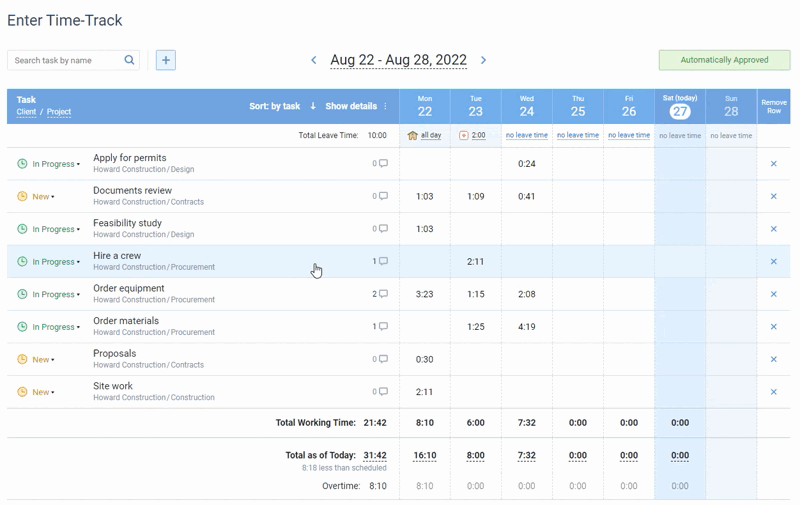
Online timesheet interface in actiTIME where every user can select task parameters
they want to see in their timesheets
3. Using pomodoros
Pomodoros prevent you from achieving deep focus and working in the flow state – a state of mind when we feel concentrated, confident and motivated to do the task at hand. Instead of preventing interruptions, Pomodoros either force you to work longer than you are comfortable with or interrupt you when you are focused on the work. Studies show that it takes about 25 minutes to return to the task after an interruption, so working in Pomodoros is a clear productivity hell that you voluntarily put yourself into.
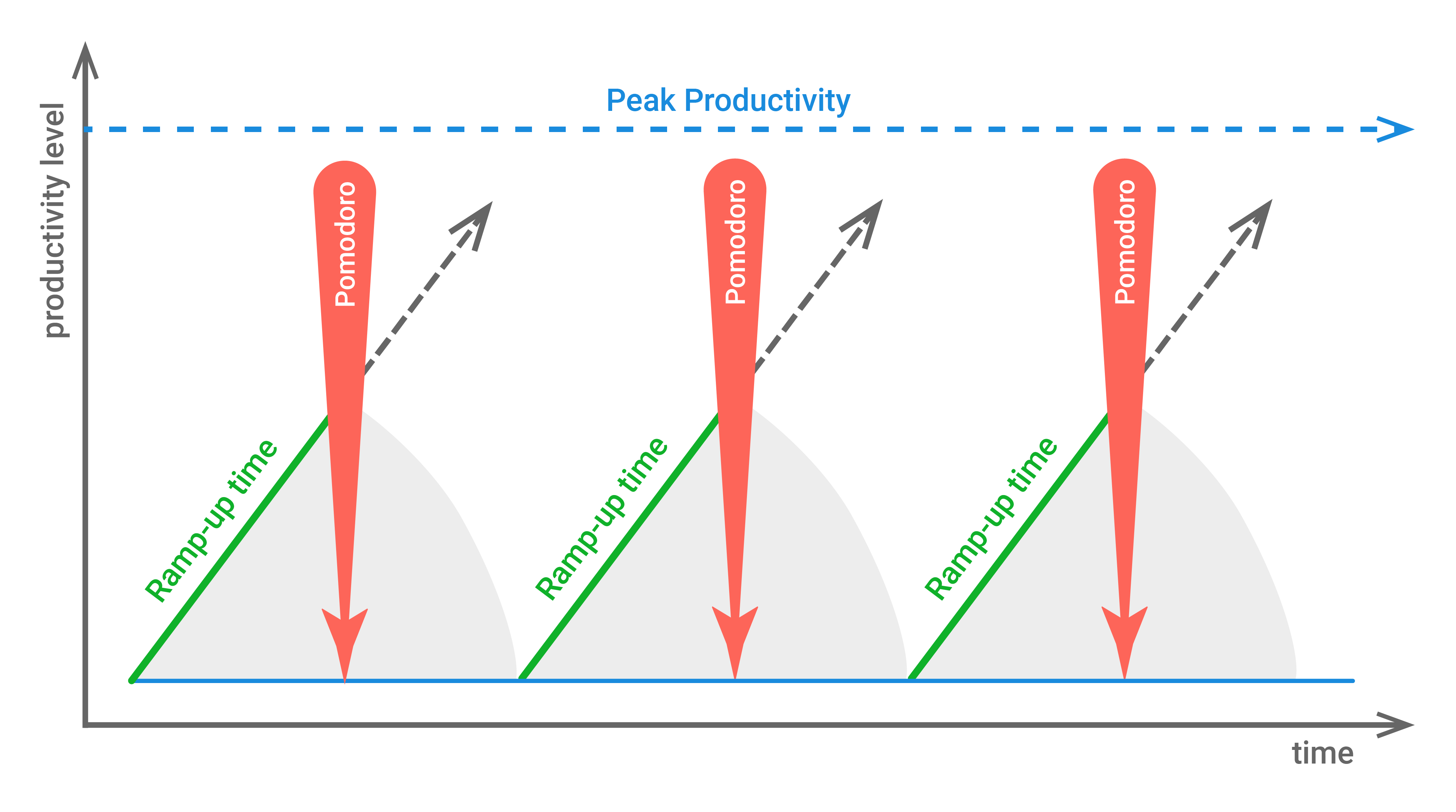
Diagram illustrating Pomodoros interrupting concentration
4. Checking social media
Social media are designed to make people addicted to scrolling news feeds and checking out for updates. Whenever you give up the temptation to reach for your smartphone, dopamine is released, making you crave it more and decreasing concentration. More than that, social media is proven to have adverse effects on productivity and wellbeing by causing anxiety, depression, stunted creativity, reduced self-esteem, distracting from life and work goals. To eliminate these risks, you need to block time for social media outside your working hours.
5. Not reviewing progress
Implement a tool where you can manage work tasks, track time, manage priorities and review your work productivity. Monitoring your performance regularly is important to identify productivity patterns, develop more efficient work practices, monitor your task and project career progress and use productivity reports to ask for a raise and advance your career. Start with free time tracking software like actiTIME to improve your productivity now.
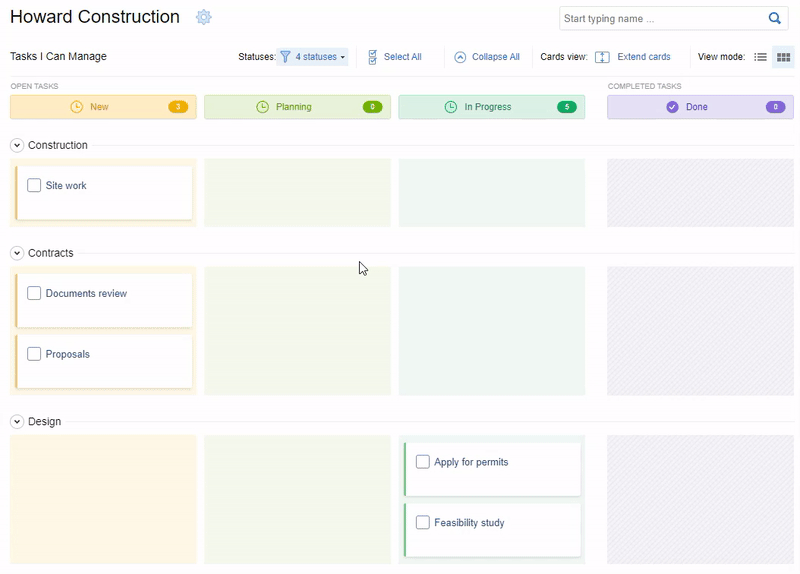
Kanban board in actiTIME displaying custom workflow statuses
and allowing you to easily drag-and-drop tasks between their statuses
How to Measure Productivity in The Workplace
Measuring something as impalpable as productivity might sound challenging, but it’s very doable as long as you have a clear picture of what you’re trying to accomplish.
How to measure team productivity
Team productivity is where graphs, charts and formulas based on various quantity indexes still reign supreme. Weekly, monthly, quarterly reports, statistical data, balance figures – all collected, processed, compared, and analyzed to determine the level of productivity and efficiency of a given team.
The key objective here is to establish input and output. What is the best metric that represents the result of teamwork? Is it the number of tasks accomplished, new customers acquired, or the amount of revenue gained? It all depends on your company’s profile, and the goals your team is trying to achieve. The general practice, however, is using the number of successfully accomplished tasks as a measure of a team’s work output.
With input, on the other hand, things are a bit more straightforward. It’s usually time, with results evaluated against specific periods: weeks, months, quarters, years, etc., which is why keeping track of it is such a crucial element if you want your productivity analysis to be accurate. Knowing how much time your team spends on specific projects or individual tasks not only helps you see their performance overall, but also identify any problematic areas, and spot any trends before they get a chance to leave a major negative impact on the company.
For example, you may introduce time tracking software in your company and get your team to track their time against their assignments. You may discuss time estimates for each task at your team meetings and specify them in your software to remind employees to stay focused. If you notice serious overruns, use it to dig into the roots of the problem.

they want to see in their timesheets
Another tool for measuring team productivity is analytics tools such as charts and reports. Usually, you can use them to see time distribution across tasks and projects, compare time estimates with actual working time, overtime and leave time amounts to review productivity trends from different angles.
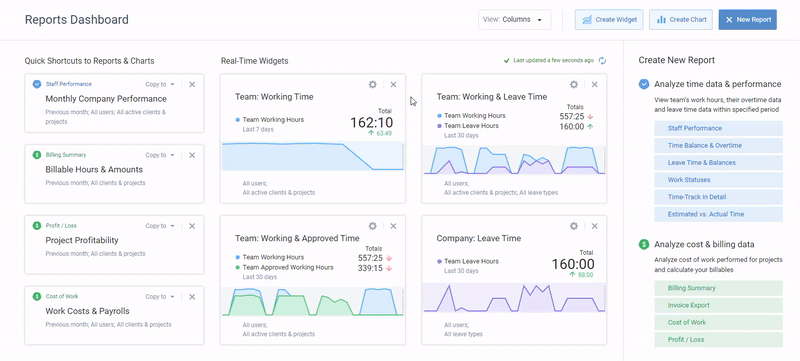
and add report shortcuts for quick access
Notice that all these tools and features are based on registered working time: productivity systems use time to measure team efforts. The same goes for measuring individual performance.
How to measure individual productivity
When it comes to individual productivity, there seems to be a bit more leeway for qualitative evaluation. Mostly because personal output is a lot easier to assess in quality terms. If you’ve ever filled out a customer feedback form, you probably remember how it asked you to name a specific employee.
And again, time is the primary type of input when evaluating individual productivity as well. It’s a precious and non-renewable resource, so keeping an eye on where you spend it is truly vital. You may not realize just how much of your time goes wasted on routine and non-essential tasks and distractions every day. Time that you could invest into more important projects instead.
If you utilize a time and productivity tracking system, you can measure individual work productivity based on the time registered by employees. For example, one of the easiest ways to discipline your workers and measure their input is to discuss time estimates with them, log these amounts in the time tracking system and see how your workers perform. If you notice any overruns, inquire employees about them to identify roadblocks, ineffective practices or slacking off workers.
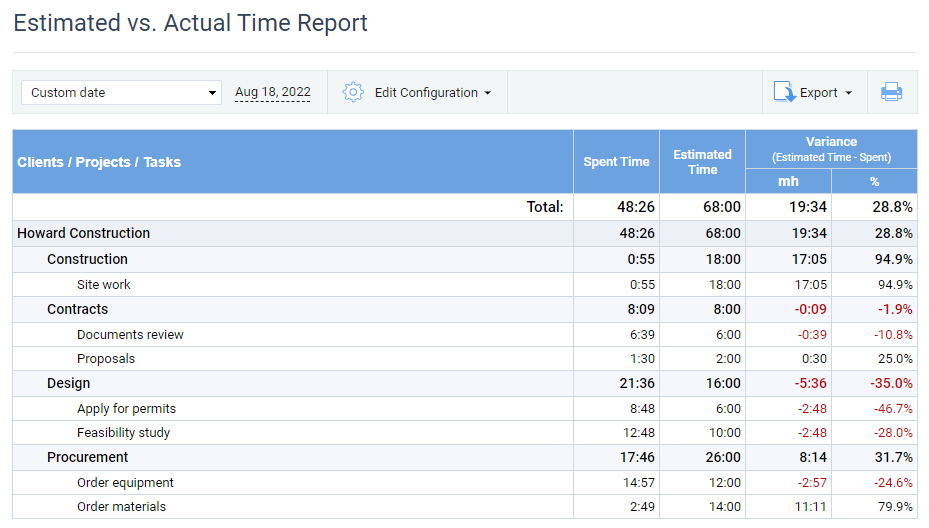
See how calls, emails and meetings in this diagram take up to twice as much time as estimated? These overruns indicate that your employees spend too much time on administrative tasks instead of focusing on tasks with the most output. It means that as a manager, you are required to look into ways to improve, automate or minimize these to invest time in assignments that move your business forward.
How to Increase Employee Productivity
So you’ve established your goals and key metrics, reviewed the data and have your first results. Great! But what do you do to improve?
Increasing team productivity
There are plenty of popular methods and practices of improving team productivity, which we’re not going to waste your time here. Instead, we’ll take a look at some of the less obvious ones.
-
Break down larger projects into smaller, more actionable tasks.
Having a large project with a strict deadline hanging around your team’s collective neck is overwhelming and intimidating. Breaking it up into smaller and more manageable tasks motivates people to take action and makes it easier to keep track of their progress.
-
Help your team prioritize.
As their list of tasks grows, it can become increasingly difficult for employees to concentrate. Be sure to constantly communicate the top priorities to your team and direct them to the tasks that are more valuable to the company at a given time. That way they will always know what to focus on, and spend their time on tasks that are actually important.
-
Discourage multitasking and overtime.
When people feel really invested in a project or a task that they’re working on, they can be tempted to go a bit overboard with their commitment. Doing multiple things at the same time or working longer hours only leads to wasted time and stress respectively. Perhaps ironically, it actually makes you less productive.
-
Encourage collaboration by fostering positive company culture.
Employees tend to feel a lot more positive and happy about their work when they’re surrounded by positive and happy people. And when they know one another, they feel more comfortable about collaborating and sharing ideas with their teammates. Which in turn leads to better and faster results for the company.
Increasing individual productivity
What can you do to improve your personal work productivity? In addition to getting better at time management, there are a few other great techniques that could help you do more in less time.
-
Work smarter.
Keep track of your progress on a project in a visual format and update it as you complete tasks to keep yourself motivated. Take regular breaks to rest and recharge in between intense work sessions. When feeling truly stumped, switch to a different task or take some time off and tackle it again the next day with renewed energy.
-
Start your day with the most important thing.
By making a habit out of tackling the most important or difficult tasks during the first half of the day, while your mental energy is at its peak, you greatly increase your chances of making actual meaningful progress.
-
When stuck, kick yourself back into gear with smaller tasks.
If you’re struggling with a particularly challenging or large task, pick a few smaller ones that you know you can complete. Use that positive momentum to keep your productivity snowball rolling.
-
Stop chasing perfection.
Try to be more realistic about your goals and standards. Working on a task for days in an effort to deliver the best possible result (instead of delivering any result) is counterproductive in the extreme. If the work you’ve done checks all the boxes, then it’s good enough, and you can move on to whatever’s next on your list.
Ready to Improve Work Productivity?
Measuring work productivity is a tricky task, especially when it comes to workers in knowledge heavy fields. And while data and stats do matter, it’s important to remember that they mean very little in and of themselves. Without meaningful and concentrated effort on your part, they will remain just numbers, and to improve productivity you need to take actual steps.
One of the first steps towards improving work productivity is implementing a time tracking system like actiTIME that turns working hours into productivity analytics with charts and reports. Give it a try – start a free 30-day trial (no credit card required).















































